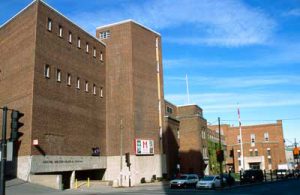
By Mackay L. Smith
Ironically enough, if you are one of the thousands of students, staff or faculty members who run, lift, swim or play at the Currie Memorial Gymnasium each year, you have smokers to thank in part for the top-flight facilities.
The original gymnasium was paid for by a bequest from the Estate of Lord Strathcona and donations from the Graduate Society. Some of the funds for the original $350,000 price tag were also raised through sales of McGill-brand cigarettes – complete with the University logo. Macdonald Tobacco agreed to split the profit from every pack sold with McGill, with the money going toward construction of the new facility.
The gym is officially called the Arthur Currie Memorial Gymnasium and Armory and was named after Currie, a legendary figure in Canadian military history who rose from the very bottom ranks as a militia gunner to become the first Canadian to achieve the rank of full general during World War I. Nicknamed Guts and Gaiters for his courage on the battlefield combined with his aloof manner, Currie was a decisive field commander – distinguishing himself on numerous occasions including orchestrating the famous Canadian victory at Vimy Ridge.
Currie served as Principal of McGill from 1920 until his death in 1933.
Work on the new brick gym advanced rapidly with the onset of World War II in 1939. Due to the limited funds at the time, no ornamentation was to be found throughout the structure. The Canadian armed forces used the gym as the physical training headquarters for its Canadian Officers Training program.
In 1947, the gym was extended and a pool was added. That same year, construction began on a separate building, Memorial Hall, where the names of McGill graduates who were killed in WWI and II are inscribed on the walls.
In 1991-92, chemist, entrepreneur and philanthropist Richard H. Tomlinson (PhD ’48), gave $5 million to build to build the Fieldhouse that bears his name today. (In 2000, Tomlinson eclipsed even his own generosity by giving more than $64 million to the University to create Fellowships – one of the biggest gifts in Canadian university history.) Attached to the gym, the Fieldhouse boasts a six-lane, 200-metre indoor track and three indoor tennis courts.
Today, the Currie Gym is part of the McGill’s state-of-the-art Sports Complex, that also houses the McGill Sports Medicine Clinic, the Seagram Sports Science Centre, the Weider Fitness Centre, Memorial Pool, seven international squash courts, a host of dance studios and the Tomlinson Hall where McGill Athletic Awards are on display.
Each year, the Complex is used by some 9,000 McGillians and 700 teams taking part in the University’s extensive intramural sports program. An additional 6,000 people come to the facilities to take instructional courses that range from yoga to staff fitness. More than 600 student-athletes play on 29 varsity teams. Seventy per cent of all full-time students use the Sports Complex – making it one of the most popular facilities at McGill.
McGill Memories is a regular feature based upon Mackay L. Smith’s 2009 book, Memories and Profiles of McGill University. The book is available at the McGill bookstore.
